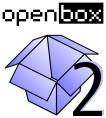
Openbox
Changelogs
Documentation
|
Openbox Features
Anti Aliased Fonts
Openbox makes use of the XFree86 Xft extension to anti-alias fonts. This
feature is optional--it can be turned off in the
rc file.
Both Xft and non-Xft font directives are supported, and
non-Xft fonts are appropriately fallen back to when Xft is not
available. Anti-aliased fonts screen shots can be seen here.
NetWM Support
Openbox has fairly complete support for the
NetWM X11
Spec. Openbox is therefore compatible with any NetWM tools or
desktop environments, such as KDE 3 and Gnome 2.
Highly Configurable NetWM Keygrabber
More info on Epistrophy, the official Openbox keygrabber,
can be found here.
Window-to-Window and Window-to-Edge snapping
Openbox windows can snap to each other and the workspace edge. Two
types of snapping is supported: classic snapping, where windows are
snapped when they are brought within a certain distance of each other
or the workspace edge, and resistance, where windows are pushed
against each other (or the edge) and resist being pushed over each
other for a certain threshold. The threshold in both cases is
customizable.
Xinerama Support
Openbox can optionally be built with support for the Xinerama extension. The
Xinerama extension allows you to join multiple monitors into a single logical
monitor. As you can imagine this can be a pain when the window manager starts
placing new windows halfway between monitors, or maximizing a window across
them all.
When you compile in Xinerama support, a new menu will appear in the main
configuration menu with Xinerama specific options. Openbox can be made
Xinerama-aware in a number of ways. It can be made to snap windows against
boundaries between monitors, it can be made to place windows with monitor
boundaries in mind, and it can be set up to only maximize windows on a single
monitor at a time.
Several Window Placement Options
Openbox supports the following placement options:
- Smart - sporting a new and improved algorithm
- Cascade
- Under Mouse - windows are placed under the mouse cursor
- Click Mouse - windows are placed under the mouse after a position
is chosen by the user and the mouse is clicked
This is configurable in real time, in the configuration menu. Openbox
can also be configured so that window placement ignores shaded and/or
fully maximized windows.
Workspace Warping
Windows can be moved from one workspace to another by moving the window
over the workspace edge until the mouse pointer hits the edge.
Configurable Mouse Buttons
Mouse buttons can be reconfigured to open different menus. This is
desirable for apps which steal middle and/or right button clicks, so
you can configure Openbox to open the root menu by left-clicking the
desktop, for example. See the rc file
here and
here.
Use of Mouse Wheel
The mouse wheel can be used to shade and unshade windows (by rolling
the wheel anywhere on the title bar) and to change workspaces (by
rolling the wheel anywhere on the root window). See the
rc file.
Highly Customizable Style Engine
Openbox has a fast gradient engine--all pixmaps (with a few
exceptions) are created on the fly, using color and gradient type
directives in style files. Since it is hard to specify a sane pixmap
pattern for buttons in the style file, Openbox supports XBM files for
its four title bar buttons. The XBM's can be created separately, (in
Gimp, maybe) and the paths to the files are specified in the Openbox
style.
Windowmaker Dock App Support
The slit is a location on the desktop where Windowmaker dock apps can
be placed. The slit's location, direction and auto-hide property are
customizable in real time.
Toolbar
The toolbar is a very basic tool (included in Openbox) which offers
the most basic functionality, in case the user does not have a
keygrabber. The toolbar allows the user to cycle workspaces and
windows using the mouse, and holds the current window's title, current
workspace name, and a customizable clock.
If the toolbar is not desired (when running KDE, for example), it can
be completely removed from the screen, in the main configuration menu.
|
|

